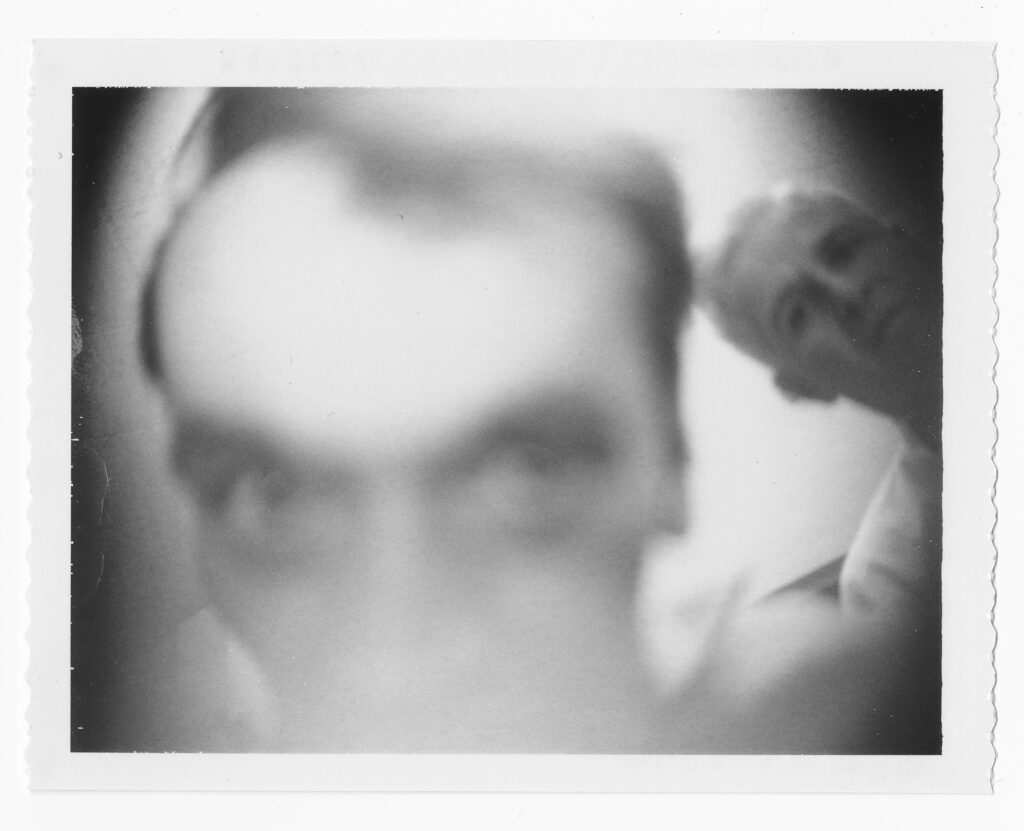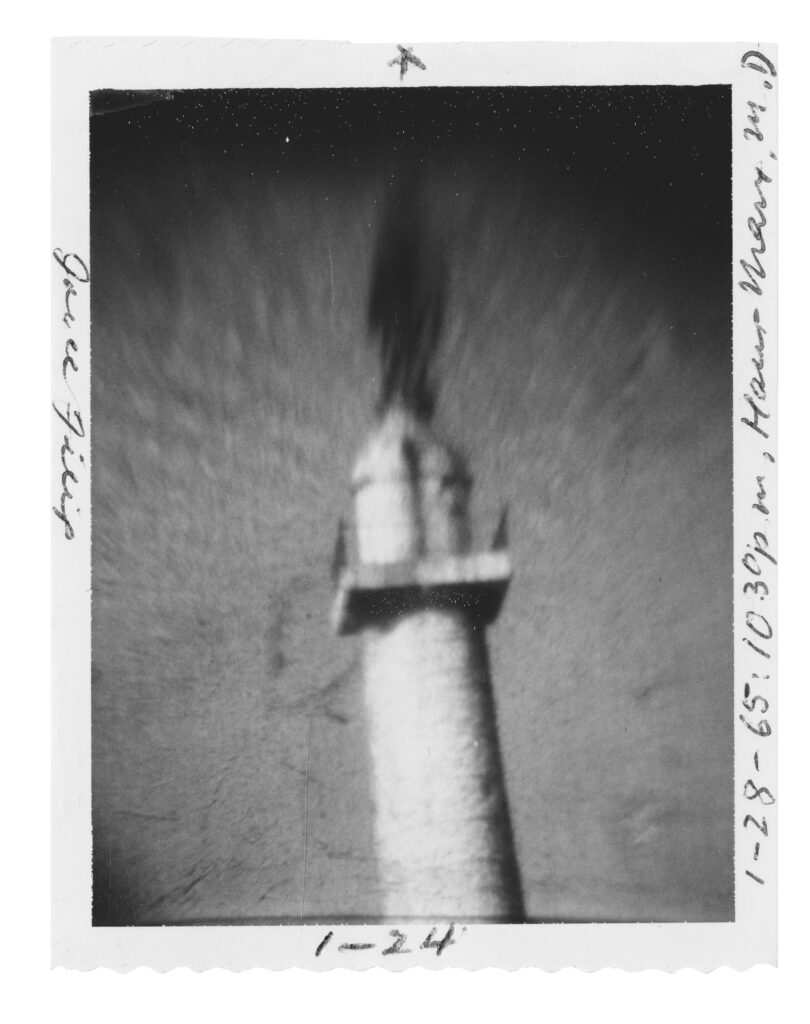Ted Serios was a bellhop at the Conrad Hilton Hotel on Michigan Avenue, though probably not the kind of employee they expected. When he worked as a valet, he had a habit of joy riding in the guests’ cars. When he manned cash registers, he took home a dollar or two. He ran into police now and then. He had a history of alcoholism, and erratic behavior and was declared schizophrenic during a brief stay at Chicago State Hospital.
He also claimed to have incredible powers.
Paranormal abilities, some said.

He would stare hard at a camera. He would convulse and growl and twist his arms and contort his expression and, by claiming to focus his thoughts, project an image from his mind onto undeveloped film. At least, that was his claim. “Get in there, baby,” he would whisper at cameras. “Come on, you son of a …” Then he’d collapse back in a chair, tired.
It was very dramatic, pretty easy to roll your eyes at.
Except, Serios would do this with Polaroid instant film, a relatively new process. And generate immediate results — foggy, abstracted dreamscapes of the Art Institute, Water Tower, Westminster Abbey, a bird’s-eye view of the Pentagon. Plenty of journalists, photographers and even magicians came forward to explain the whole thing was a scam, though 60 years later, it’s still difficult to prove conclusively Serios was a fraud.
Certainly, he had a little carny in his blood — his father, a Greek immigrant, toured the Midwest as a professional wrestler and settled the family in Chicago when Serios was a child. Other than several years in Denver where Serios’ supposed abilities were treated as a research lab cause celeb, Serios spent much of his life in Illinois; he died in 2006 at age 88, having lived in the small western town of Quincy on the Iowa border. He was a C-list media blip in the ‘60s and a campfire tale by the ‘90s. A 1999 Tribune article concluded with the author wondering where Serios was and if he was still practicing his “thoughtography”:
“So if you’re out there, Ted?”

Two decades later, the story has taken an interesting twist. Serios, and paranormal photography in general — common enough since the 19th century to have become a kind of quasi-genre of photography — is now admired by art historians and shown in major museums, not for the miraculous qualities of the images but for the work itself.
“I actually credit Ted Serios’s photographs for getting me interested in photography in the first place,” said Paul Roth, director of the Image Centre photography museum at Toronto Metropolitan University, which exhibited a collection of Serios’ work earlier this year. As a child, Roth saw Serios’ mind photos in a documentary on the paranormal, “and it really struck me how photography could be magical and full of enchantment, in so many ways, even if Ted never intended that. It’s a feeling we all take for granted now, of course. He seemed to show proof that you can travel inside your mind and actually throw thoughts on film, an extraordinary statement about photography itself, which has long been taken as literal proof of reality. Ted was the purest metaphor for that idea — he was like a county fairground version of how we think about the internet now.”
As the social media cliché goes: If there aren’t pictures, it didn’t happen.
Unless, of course, photography is more complicated than that.
The results of Ted Serios’ thoughtography have been part of exhibitions at the Metropolitan Museum of Art in New York City and Maison Europeenne de la Photographie in Paris. This month, there’s even a book, “Ted Serios: The Mind’s Eye,” a companion to the Toronto show. Emily Hauver, who organized that exhibit, is a curator at University of Maryland, Baltimore County, which began collecting Serios’ work in 2002. She said that although his photos weren’t intended as art, they were “right on trend” with the history of the medium. She notes they arrived about the time of Robert Frank’s “personal and poetic” black-and-whites from his book “The Americans,” and somewhat foretold the “dreaminess, distortion and ambiguity” of later photographers.
Moreover, the photos “are still relevant today in a culture where photography has become ubiquitous. How many of us send a photo to a friend that is intended to communicate entire thoughts?” Not to mention, she adds, Serios’ photos do look “like they could have emerged from the depths of someone’s unconscious mind.” Surrealist artists, after all, insisted their work arrived through an unconscious, automatic hand.
Serios just skipped the middleman.
Indeed, in a way, if unintentionally, he was broadening our understanding of photography to see beyond the range of the human eye. By the end of the 19th century, said Katerina Korola, an art historian at the University of Minnesota and teaching fellow at the University of Chicago, photography could show “the distinct phases of the horse’s gallop, crystalline structures found in human saliva, the interior of the body as revealed by X-rays.” Photography, she said, had revealed so much, that it gave “rise to speculations about what other hidden phenomena the photographic image might yet bring to light.”
Psychic photography was a stretch — but then so were X-rays once.
So, throughout the 1960s, Serios was studied by researchers at the Field Museum and the Art Institute, the Illinois Society for Psychic Research and National Guild of Hypnotists, the Borg-Warner Research Center in Des Plaines, University of Virginia Medical School, and, most extensively, University of Colorado Medical School. Later, he was profiled by Leonard Nimoy’s “In Search of …” paranormal TV series and became the basis of an unmade biopic by “X-Files” creator Chris Carter. He was also dismissed in a two-part expose by Popular Photography magazine, and dubbed a fake by the late magician James “The Amazing” Randi, who told the Tribune: “I always found Ted to be an affable con man.” But as Hauver and others note, no one came up with solid evidence of fraud.
Or proof that he was making photos with his mind.
By the early 1970s, Serios was telling reporters that he was sick of being a party trick.
“Was Ted smart enough to have faked this?” Hauver asked. “Did he do it to avoid jail time? Was it alcohol-related? A psychotic episode? If it was a scam, why didn’t he make money on it? Why did he eventually stop? I feel we will never get to the bottom of this.”
Ted Serios actually did intend to make money on it. Sort of. He got into the psychic photo business after a fellow bellhop at the Hilton tried hypnotizing and encouraging him to picture places far outside Chicago. The co-worker wanted Serios — who dropped out of school in fifth grade — to use his abilities to pinpoint the treasure of a 19th century pirate. When they practiced with a camera, Serios later said, they were shocked to see images appear on film — not exactly 19th century pirate gold, but something showed up.
He submitted himself to tests by the Illinois Society of Psychic Research, which brought its findings to Fate, a long-running (now-defunct) paranormal magazine based in Highland Park. Fate in turn introduced Serios to Jule Eisenbaud, a Denver psychoanalyst intrigued by the paranormal. When Eisenbaud was visiting Chicago on business, he met with Serios at the Palmer Hotel and ran Serios through several tests.
Eisenbaud held a Polaroid Land Camera a few feet from Serios’ head. He asked Serios to picture various images. Serios, who said he worked better drunk, put away a lot of beer. At first, the photos were blank. But after hours, Serios made an image of Water Tower. He went on to make several more images, including blurry Chicago marquees. Sometimes Serios generated images of himself staring headlong into the lens, but more often the photos were full of muted shadows, closer to suggestions of places and things.
Much of the time, Serios also rolled a piece of cardboard or plastic into a tube and pointed it at the camera — to better direct his thoughts, he insisted. Of course, though the tube wasn’t always used by Serios, it became the focus of naysayers, who assumed Serios managed to slip transparencies between its folds and, somehow, work his magic.
But Eisenbaud became a true believer.
He brought Serios to Denver and, in four years of tests, put him in jumpsuits, tied him to chairs, tested him naked, placed him in rooms far away from the camera and sometimes outside of the building. Eisenbaud even tested Serios in a Faraday cage to block electromagnetic fields, and created a mountain of documentation — much of which went to the University of Maryland collection — that often located the origins of some of the images that Serios produced, including Field Museum dioramas. But by the end of the 1960s, though, Eisenbaud’s tests generated a bestselling book (“The World of Ted Serios: ‘Thoughtographic’ Studies of an Extraordinary Mind”) and a burned-out subject.
Like an old Polaroid, Ted Serios gradually faded away.
What’s left are those photos.
Looming foreheads. Shadowy trestles. Nonsensical flashes of movement.
Nearly every one mundane — except for the method, and a splash of light. Not quite art photography. Not outsider art. Barely representational. If anything, they look like early photographic experiments. When I asked Blake Stimson, an art historian at the University of Illinois at Chicago, about early reactions to photography, he told me of scientists who thought of photos as “sun drawings” and of Walt Whitman, who saw photographers as poets who caught “sun falling around a helpless thing.” Sounds like Serios’s images. But so does the use of the paranormal in photography, from the “spirit photography” of the 19th century that claimed to insert ghosts of dead Civil War soldiers into family portraits, to more contemporary images that claim to capture the Loch Ness Monster and Bigfoot.
But that’s fakery.
Serios didn’t appear to tamper with the film itself after the image was captured. (Some insisted he worked with previously exposed film — though, again, could not prove it.) Serios wasn’t even the first to try to photograph human thoughts; Japanese and French photographs tried decades before he started as a bellhop. But Paul Roth sees a great deal in Serios’ images: the imperfectness of toy cameras and the images made by the cracks in camera shells. “The aesthetics of Ted’s photographs resonate in so many different ways today, it doesn’t really matter to me if Ted Serios was a fraud or a genius.
“I even find it unhelpful to try and decide if he was a fraud. As soon as you do, the joy is sucked from this story. Whatever yearning we have for other worlds — gone. I prefer to think of the tale of Ted Serios as a mystery wrapped in science — wrapped in a carnival.”
___
© 2023 Chicago Tribune
Distributed by Tribune Content Agency, LLC.



